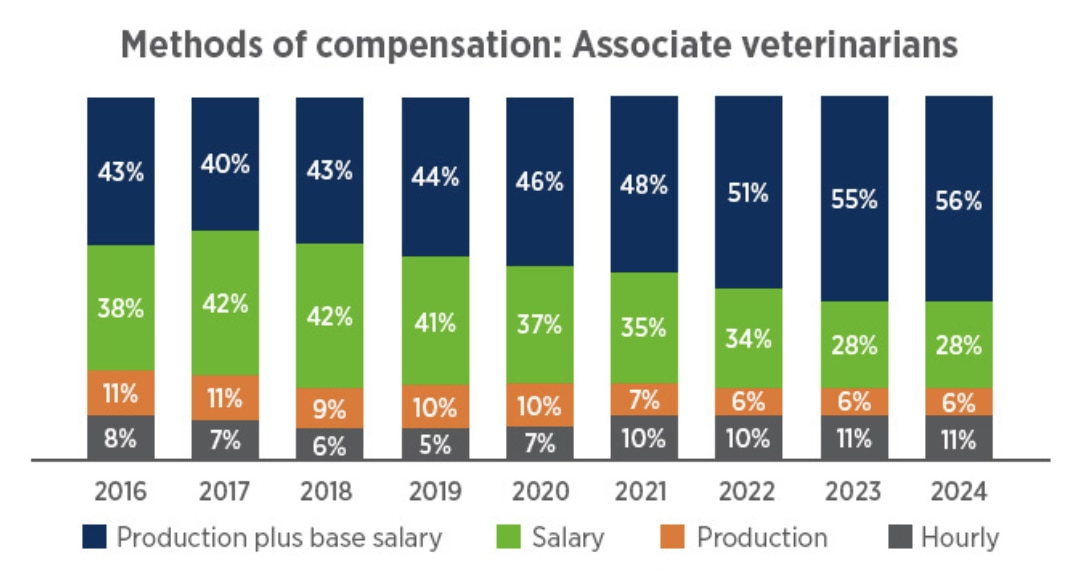A look at compensation trends

A look at compensation trends
By: AVMA
Compensation is more than just a paycheck. It can impact workplace culture, job satisfaction, and a veterinary practice’s ability to recruit, retain, and motivate talented team members.
So, how do most associate veterinarians get paid? The answer might surprise you.
What the data show
As this month’s chart shows, compensation based on production plus base salary (also known as ProSal) has gained in popularity since 2016, with more than half (56%) of associate veterinarians paid this way in 2024. On the other hand, compensation by salary or production alone has become less common.

This trend is even more pronounced for new veterinary school graduates. In 2024, 70% of those entering clinical practice reported they would be paid by ProSal, compared with just 29% reporting salary alone.
What does this mean?
Each compensation model has its advantages and trade-offs. A straight salary offers predictability and stability but can feel limiting to associates who routinely go the extra mile to serve clients and their animals. It also can be less competitive in today’s job market, especially for those with student debt. Indeed, the average associate paid solely by salary earned $121,640 in 2023, compared with $159,733 for those paid under a ProSal model and $169,809 for those paid based on production alone.
ProSal models blend the best of both worlds: generally, a guaranteed income with the chance to earn more based on productivity. However, these and other production-based schemes are not without challenges. Associates can experience income fluctuations due to changing demands for veterinary services, seasonality, scheduling, or other factors beyond their control. They also may experience stress if their compensation is linked too tightly to caseload.
From a management perspective, production-based pay can be complex to administer and, if not designed carefully, may inadvertently encourage competition rather than collaboration among colleagues. It also increases the importance of building trust and providing transparency with clients so they will be confident our recommendations are always based on what individual patients need.
Putting the data to work
Understanding trends in how veterinarians are paid can help practice leaders make informed business decisions and help associates and job seekers evaluate opportunities with eyes wide open.
For practice leaders:
- Review your compensation model. If your practice still pays by salary only, assess whether adding a production component could boost competitiveness in hiring and retention. Consider discussing the question with your associates to get their input.
- Align pay with purpose. Identify which behaviors you wish to encourage—such as preventive care delivery, teamwork, client retention, or mentorship—and design your compensation system to support those goals. Incentives can extend beyond individual production to reward measures like client satisfaction, medical quality, or contributions to practice efficiency or culture.
- Be transparent with your team. If you offer or are considering production-based pay, explain clearly how it’s calculated, what’s included and excluded, and how it affects income stability. This can help build trust, foster engagement, and minimize confusion or resentment.
For associates and job seekers:
- Look beyond base salary. If you’re job hunting or renegotiating, carefully review the production terms. Pay attention to whether production is measured on a gross or net basis, what thresholds apply, and whether any negative accrual or “clawback” provisions exist that would kick in if production falls short for a given period.
- Ask about predictability and support. As previously mentioned, production-based pay can mean higher earning potential, but also greater income variability. Find out how the practice manages slow seasons or what mentorship or training is available to help you succeed.
Source here
